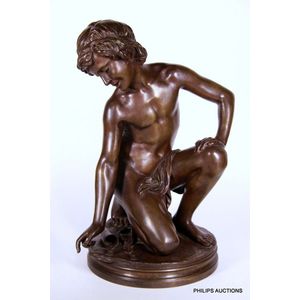7 Victorian & 19th Century Mahogany Chairs with Velvet Upholstery
You must be a subscriber, and be logged in to view price and dealer details.
Subscribe Now to view actual auction price for this item
When you subscribe, you have the option of setting the currency in which to display prices to $Au, $US, $NZ or Stg.
- Victorian Period - The Victorian period of furniture and decorative arts design covers the reign of Queen Victoria from 1837 to 1901. There was not one dominant style of furniture in the Victorian period. Designers used and modified many historical styles such as Gothic, Tudor, Elizabethan, English Rococo, Neoclassical and others, although use of some styles, such as English Rococo and Gothic tended to dominate the furniture manufacture of the period.
The Victorian period was preceded by the Regency and William IV periods, and followed by the Edwardian period, named for Edward VII (1841 ? 1910) who was King of the United Kingdom and the British Dominions and Emperor of India for the brief period from 1901 until his death in 1910. - Baluster (furniture) - An architectural term for a column in a balustrade or staircase, often defined as a "vase shape". The shape is extensively used in furniture and decorative arts.
In furniture, it is used to describe a chair or table leg turned in that form, or more usually as an inverted baluster, with the bulbous section to the top. Less commonly used to describe a chair back that has the outline of a baluster. A baluster may also be split and applied to the front of a cupboard for ornamentation.
For ceramics and silver items it is often used to describe the shape of the whole item, rather than a part.
In Georgian glassware, the shape is commonly seen in the stem of glasses. - Mahogany - Mahogany is a dense, close grained red-coloured timber from the West Indies and Central America. It was first imported into Europe in the the early 18th century and its use continued through the 19th century. It was popular for furniture making because of its strength, the wide boards available, the distinctive grain on some boards, termed flame mahogany and the rich warm colour of the timber when it was polished.. The "flame" was produced where a limb grew out from the trunk of the tree, and this timber was usually sliced into veneers for feature panels on doors, backs and cornices.
Some terms used to describe mahogany relate to the country from which it originally came, such as "Cuban" mahogany, "Honduras" mahogany etc. However unless the wood has been tested the names assigned are more a selling feature, rather than a true indication of the timber's origin.
This item has been included into following indexes:
-
chairs, sets of 6, style or period
- balloon back 83
- Victorian 218
-
chairs, sets of 6, timber
- all styles and timbers 747
- mahogany 175
Visually similar items

A mother-of-pearl gold dress ring. 18ct rose gold, made as a solitaire modern quatrefoil panel ring, featuring a polished piece of mother-of-pearl, framed by applied gold bead work as frame, set to a smooth wide band

A fine Victorian English gilt mounted walnut credenza, later 19th century, the credenza having a central cupboard flanked by curved, glazed and velvet lined display cupboards, a striking book end veneer panelled top and intricate knot and strap work throug

A bronze figure of a boy playing dice by Henry Paul Hudelet (1849-1878), a kneeling boy upon an integral circular base, inscribed signature of Hudelet, height 41 cm

Rare 10 sided single reed pewter plate c.1,800-1820s French
